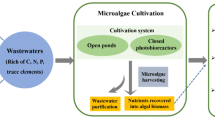Abstract
Because algal cells are so efficient at absorbing incoming light energy, providing more light energy to photobioreactors would simply decrease energy conversion efficiency. Furthermore, the algal biomass productivity in photobioreactor is always proportional to the total photosynthetic rate. In order to optimize the productivity of algal photobioreactors (PBRs), the oxygen production rate should be estimated. Based on a simple model of light penetration depth and algal photosynthesis, the oxygen production rate in high-density microalgal cultures could be calculated. The estimated values and profiles of oxygen production rate by this model were found to be in accordance with the experimental data. Optimal parameters for PBR operations were also calculated using the model.
Similar content being viewed by others
References
Rabinowitch, E. (1961) Spectral efficiency of photosynthesis. pp. 274–298. In: P. A. Campbell (ed.).Medical and Biological Aspects of the Energies of Space) Columbia University Press, New York, NY, USA.
Rabinowitch, E. I. (1945)Chemistry of Photosynthesis, Chemosynthesis and Related Processes in Vitro and in Vivo. Interscience Publishers, New York, NY, USA.
Krauss, R. W. and A. Osretkar (1961)Minimum and Maximum Tolerances of Algae to Temperature and Light Intensity. Columbia University Press, New York, NY, USA.
Thacker, D. R. and H. Babcock (1957) The mass culture of algae.J. Sol. Energy Science. Eng. 1: 37–49.
Kyle, D. J., C. B. Osmond, and C. J. Arntzen (1987)Photoinhibition. Elsevier, Amsterdam, Netherlands.
Lee, C.-G. (1999) Calculation of light penetration depth in photobioreactors.Biotechnol. Bioprocess Eng. 4: 78–81.
Lee, C.-G. and B. O. Palsson (1994) High-density algal photobioreactors using light-emitting diodes.Biotechnol. Bioeng. 44: 1161–1167.
Vonshak, A. (1986) Laboratory techniques for the cultivation of microalgae. pp. 117–145. In: A. Richmond (ed.).Handbook of Microalgal Mass Culture). CRC Press, Boca Raton, FL, USA.
Hoover, J. K. (1984)Chloroplasts. Plenum Press, New York, NY, USA.
Kok, B. (1952) On the efficiency ofChlorella growth.Acta Bot. Neerl. 1: 445–467.
Myers, J. (1980) On the algae: thoughts about physiology and measurements of efficiency. pp. 1–16. In: P. G. Falkowski (ed.).Primary Productivity in the Sea). Plenum Press, New York, NY, USA.
Pirt, S. J. (1986) The thermodynamic efficiency (quantum demand) and dynamics of photosynthetic growth.New Phytol. 102: 3–37.
Lehninger, A. L. (1982)Principles of Biochemistry. Worth Publisher, New York, NY, USA.
Stryer, L. (1995)Biochemistry. W. H. Freeman and Company, New York, NY, USA.
Hill, R. and F. Bendall (1960) Function of the two cytochrome components in chloroplasts: A working hypothesis.Nature 186: 136–137.
Emerson, R. and C. M. Lewis (1943) The dependence of quantum yield ofChlorella photosynthesis on wave length of light.Amer. J. Bot. 30: 165–178.
Pirt, S. J., Y.-K. Lee, A. Richmond, and M. W. Pirt (1980) The photosynthetic efficiency ofChlorella biomass growth with reference to solar energy utilization.J. Chem. Tech. Biotechnol. 30: 25–34.
Kok, B. (1960) Efficiency of photosynthesis. pp. 566–633. In: W. Ruhland (ed.).Encyclopedia of Plant Physiology). Springer, Berlin, Germany.
Duysens, L. N. M. (1956) The flattening of the absorption spectrum of suspensions, as compared to that of solutions.Biochem. Biophys. Acta 19: 1–12.
Morel, A. and A. Bricaud (1981) Theoretical results concerning light absorption in a discrete nedium, and application to specific absorption of phytoplankton.Deep-Sea Research 28A: 1375–1393.
Aiba, S. (1982) Growth kinetics of photosynthetic microorganisms. pp. 85–156. In: A. Fiechter (ed.).Microbial Reactions (Adv. Biochem. Eng., vol. 23). Springer-Verlag, Berlin, Germany.
Mie, G. (1908) Beitrage zur optik truber medien, speziell kolloidaler metallosungen.Ann. Phys. 25: 377–445.
Van de Hulst, H. C. (1957)Light Scattering by Small Particles. John Wiley, New York, NY, USA.
Cornet, J. F., C. G. Dussap, and G. Dubertret (1992) A structured model for simulation of cultures of the cyanobacteriumSpirulina platensis in photobioreactors: I. Coupling between light transfer and growth kinetics.Biotechnol. Bioeng. 38: 817–882.
Cornet, J. F., C. G. Dussap, P. Cluzel, and G. Dubertret (1992) A structured model for simulation of cultures of the cyanobacteriumSpirulina platensis in photobioreactors: II. Identification of kinetic parameters under light and mineral limitations.Biotechnol. Bioeng. 38: 826–834.
Frohlich, B. T., I. A. Webster, M. M. Ataai, and M. L. Shuler (1983) Photobioreactors: models for interaction of light intensity, reactor design, and algal physiology.Biotechnol. Bioeng. Symp. 13: 331–350.
Geider, R. J. and B. A. Osborne (1992) Light utilization and optical properties of algae. pp. 122–155. In: R. J. Geider and B. A. Osborne (eds.).Algal Photosynthesis (Current Physiology). Chapman and Hall, New York, NY, USA.
Geider, R. J. and B. A. Osborne (1987) Light absorption by a marine diatom: experimental observation and theoretical calculations of the package effect in a smallThalassiosira species.Mar. Biol. 96: 299–308.
Kok, B., B. Forbush, and M. McGloin (1970) Cooperation of charges in photosynthetic O2 evolution—I. A linear four step mechanism.Photochem. Photobiol 11: 457–475.
Kok, B. (1953) Experiments on photosynthesis byChlorella in flashing light. pp. 63–75. In: J. S. Burlew (ed.).Algal Culture from Laboratory to Pilot Plant). Carnegie Institution of Washington Publication, Washington, DC, USA.
Kok, B. (1956) Photosynthesis in flashing light.Acta 21: 245–258.
Phillips, J. N. and J. Myers (1954) Growth rate ofChlorella in flashing light.Plant Physiol. 29: 152–161.
Weller, S. and J. Franck (1941) Photosynthesis in flashing light.J. Phys. Chem. 45: 1359–1373.
Park, K.-H., D.-I. Kim, and C.-G. Lee (2000) Effect of flashing light on oxygen production rates in high-density algal cultures.J. Microbiol. Biotechnol. 10: 817–822.
Park, K.-H. and C.-G. Lee (2000) Optimization of algal photobioreactors using flashing lights.Biotechnol. Bioprocess Eng. 5: 186–190.
Fredrickson, A. G. and H. M. Tsuchiya (1970)Utilization of the Effects of Intermittent Illumination on Photosynthetic microorganisms. Center for Agricultural Publication and Documentation, Wageningen, The Netherlands.
Lee, C.-G. and B. O. Palsson (1995) Light-emitting diodebased algal photobioreactor with external gas exchange.J. Ferment. Bioeng. 79: 257–263.
Lee, C.-G. and B. O. Palsson (1995) Continuous medium perfusion leads to long-term cell viability and oxygen production in high-density photobioreactors.Biotechnol. Lett. 17: 1149–1154.
Author information
Authors and Affiliations
Corresponding author
Rights and permissions
About this article
Cite this article
Kim, NJ., Lee, CG. A theoretical consideration on oxygen production rate in microalgal cultures. Biotechnol. Bioprocess Eng. 6, 352–358 (2001). https://doi.org/10.1007/BF02933005
Received:
Accepted:
Issue Date:
DOI: https://doi.org/10.1007/BF02933005




